All published articles of this journal are available on ScienceDirect.
Perceptual Pigeon Galvanized Optimization of Multi-objective CNN on the Identification and Classification of Mango Leaves Disease
Abstract
Aims
The aim of this study is to develop a strong Multi-objective Convolutional Neural Network (MOCNN) optimized using Perceptual Pigeon Galvanized Optimization (PPGO) for accurate identification and classification of mango leaf diseases. This approach aims to increase classification accuracy, computational efficiency, and generalization ability. The ultimate goal is to improve disease management in mango crops through advanced image-based diagnostic techniques.
Background
Demands for the consumption of mango (Mangifera indica) fruit and its leaves were growing exponentially in all parts of the world due to its large health benefits for various organs in the human body. However, these plants were largely exposed to various kinds of microbial diseases during cultivation despite the application of pesticides. Hence, it is becoming a significant threat to the farmers and to the food industry.
Objective
The objectives of this study are to develop reliable methods for the early identification of mango leaf diseases, enabling prompt intervention and reducing crop damage. Additionally, the study aims to provide effective disease management applications that will help farmers minimize crop losses and maintain their economic stability.
Methods
PPGO is an advanced optimization algorithm inspired by the natural foraging behavior of pigeons. It integrates perceptual hashing and galvanic responses to adaptively adjust the search process, allowing for efficient exploration and exploitation of the solution space. The multi-objective convolutional neural network is trained to minimize a composite loss function that considers classification accuracy, computational efficiency, and generalization error.
Results
The Perceptual Pigeon Galvanized Optimization (PPGO) with a Multi-objective Convolutional Neural Network (MOCNN) demonstrates superior performance compared to traditional CNN optimization techniques. The results show an accuracy of 96%, recall of 94%, precision of 92%, and an F1 score of 92%. These metrics surpass those of existing methods such as Efficient Supervised Learning based on Deep Neural Network (ESDNN), Hierarchical Deep Learning Support Vector Machine (HDLSVM), Ordinal Regression Neural Network (ORNN), Deep Convolutional Generative Adversarial Network (DCGAN), Convolutional Neural Network (CNN), Local Contrast Normalization Convolutional Neural Network (LCNN), and Visual Geometry Group Network (VGGNET 19).
Conclusion
The integration of Perceptual Pigeon Galvanized Optimization with a Multi-objective Convolutional Neural Network offers a powerful approach for identifying and classifying mango leaf diseases. The proposed method effectively balances multiple performance metrics, leading to a robust and efficient model suitable for real-world agricultural applications.
1. INTRODUCTION
Mango (Mangifera indica) is a vital horticultural crop among other crops grown under tropical atmosphere conditions and it is exponentially increasing the country’s economy. Especially mango fruit and its leaves are consumed to a large extent in various parts of the world due to a wide variety of health benefits. Furthermore, due to various environmental factors, mango plants were exposed to various kinds of microbial diseases at all stages of the growth cycle during cultivation despite the application of fertilizer and pesticides in varying environments. Hence, it is becoming a significant threat to food security. In order to yield value-added products, early disease detection and control are becoming more vital for the analysis of its symptoms [1].
Many studies related to the employment of manual methods for early detection of leaf disease remain highly challenging and time-consuming due to infrastructure. With the advancement of technology, it is possible to implement the automated method to recognize and categorize the mango plant disease through both machine learning [2] and deep learning architecture [3]. Many researchers have implemented the machine learning architecture to recognize and categorize diseases, however, it still leads to over-fitting and under-fitting issues [4] in the processing of the acquired images under various environmental conditions and feature processing steps of the architecture.
In this paper, a new deep learning architecture entitled multiobjective convolution neural network is proposed. The proposed architecture has been trained and validated using the plant village dataset. In the training phase, image pre-processing, segmentation, feature extraction, and feature selection are carried out to enhance the efficacy of the network in identifying and clustering of seed instances. In particular, pre-processing is carried out using contrast limited adaptive histogram equalization [5], and the pre-processed image is segmented into several segments of the disease-infected parts of the leaf images using the region growing technique [6].
The segmented region is employed for nonlinear discriminant analysis [7] to obtain the features of the disease region, and finally, the extracted feature is applied to Perceptual Pigeon Galvanized optimization [8] to generate the optimal features as seed points for the classification of diseases. The further trained model produces increased computation speed and classification accuracy to identify and classify the infected region of plant leaves with small variance to represent disease types such as bacterial, fungal, and viral on familiar mango leaf diseases like algal leaf spot, anthracnose, powdery mildew, and phoma blight [9] etc.
The flow of the manuscript has been partitioned into multiple sections. Initially, Section 2 represents the analysis of the literature employed to detect plant disease through machine learning architecture and deep learning architecture on several disease categories. Next, Section 3 defines the methodology for mango plant disease detection and classification through a multi-objective Convolution Neural Network with the optimal features selected using Perceptual Pigeon Galvanized optimization. Furthermore, the optimal features were obtained using non-linear discriminant analysis of segment image regions using the region growing technique. Finally, Section 4 mentions the experimental analysis of the model using the dataset along with its performance analysis using cross-fold validation. Section 5 finalizes the articles with suggestions for research.
2. RELATED WORK
This section describes several traditional methods that use deep learning and machine learning architecture to analyze texture and color information of disease regions in order to identify and categorize mango plant leaf diseases.
2.1. Bacterial Foraging Optimization of Radial Basis Function Neural Network
In this literature, the plant affected with no disease was detected and classified using computer vision technique. As appropriate, the diagnosis of such diseases is possible by analyzing the plant pathology. Initially, disease segmentation of the affected regions in the plant image are segmented using soft computing approaches. The application of the segmented region aids in the optimization of the Radial Basis Function Neural Network's bacterial foraging for detecting and classifying mango plant diseases within the divided regions. It has the capacity to achieve higher recognition accuracy [10]. It leads to overfitting issues.
2.2. Deep Convolution Neural Network with Local Binary Pattern Features
In this literature, accurate detection and classification of mango plant diseases is carried out using deep learning architectures. Initially, it undergoes a preprocessing and segmentation process to attain increased recognition accuracy and reduced computation time. Segmented disease region is processed further using a local binary pattern to extract the features of the disease segments. Finally, the extracted feature is processed in the deep convolution neural network to classify and detect disease into various types. In Particular, a Convolution Neural Network is capable of mapping the hidden patterns of the feature in the fully connected layer by using an activation function [11]. It is capable of detecting only a small number of diseases.
2.3. Improved Yolo Model
In this literature, the Yolox model is employed to detect the severity of plant diseases. It especially uses a modified Spatial Pyramid Pooling (SPP) layer to extract similar features at multiple scales. The extracted feature is concatenated with multiple features pooled from smaller scales to larger scales. Further, various skip connections are used to generalize the disease. In order to increase network convergence, a regression loss function was employed to reduce the over-fitting issues [12]. It leads to high computation time as the skip connection is incorporated.
2.4. Feed Forward Neural Network and Metaheuristic Approach
In this literature, Feed Forward Neural Network and metaheuristic approaches were employed for the feature selection and classification of mango leaf images. It is considered a consistent and error-prone model as it is capable of detecting several measurements of the features representing the disease. Finally, it is suitable to use both low and high-resolution acquired image datasets of the farm regions [13]. It faces a long propagation time as it incorporates the feed-forward architecture.
2.5. Leaf Net: A proficient convolution neural network approach
In this literature, a proficient convolution neural network has been employed to detect seven prominent mango leaf diseases. It is considered a multiclass classification technique. Hence, it is capable of identifying the condition of mango leaves for seven prevalent diseases, including Anthracnose, Powdery Mildew, Bacterial Canker, Cutting Weevil, Die Back, Gall Midge, and Sooty Mould. Furthermore, it uses the Support Vector Machine classifier in the softmax function. It processes the image with both global and local features, which simultaneously increases the classification error [14-18].
2.6. Multilayer Convolution Neural Network Approach
In this study, a multilayer convolution neural network is employed to process the disease images of mango leaves. Specifically, the feature maps generated using the global feature extracted from the local binary pattern method will be classified using a softmax classifier. A major limitation of this study is the convolution size, as it leads to large processing layers [19].
2.7. Neural Network and Support Vector Machine Approach
The support vector machine employing neural network identification of mango leaf diseases is the foundation of our work. Instead of using a standard approach, a neural network ensemble is used for MLDR (Mango Leaf Disease Recognition) to accurately diagnose the ailment and provide assistance. Using machine learning, multiple leaf symptoms can be used to monitor and identify mango leaf diseases. Images of leaves damaged by various diseases are gathered using a process called classification to get trained data. For identifying the symptoms of mango leaf disease with an average accuracy of 87.5%. The limitations of this paper are that it needs more focus on texture-based features and color features to improve accuracy [7].
2.8. A Novel Segmentation and Vein Pattern Technique
This work relies on the categorization and identification of mango leaf disease through the use of innovative segmentation and pattern techniques. A difficulty of automated recognition of mango plant leaf disease is the variance in symptoms and, based on the advice of mango experts, using computerized means are not practical or affordable for manual disease diagnosis. Through the use of fusion-based CCA (Canonical Correlation analysis), the sick leaf segments are based on their vein pattern. Support Vector Machines (SVM) are used as a final identification method to validate the outcome. Only a few mango leaf diseases are identified, such as powdery mildew and sooty mold; however, attention should also be directed toward other diseases [20-24].
2.9. Fully Resolution Convolutional Network Technique
The full resolution convolutional network was used in this article to identify mango leaf disease. The disease is segmented byautomated leaves due to the variance in symptoms that they are still identifying. The primary requirement of the disease under precise segmentation is the ability to identify the disease from any computer-aided system. We proposed a fully convolutional network (FCN)-based segmentation model for diseased mango leaves, utilizing a CNN (Convolutional Neural Network) to address this problem.The strategy for pre-processing the input data after applying each pixel under the features in the way that is directly suggested based on the familiar features. Segmentation accuracy is low, and needs to improve [25].
2.10. EfficientNet Deep Learning Model
The classification of plant leaf disease using an effective net model and deep learning was the basis for this work. In order to diagnose the disease using modern methods and symptoms that are obvious for all plant diseases, the plant leaves were infected using optical observation. The diagnosis is the accomplishment of another fact and the laborious, slow process of manually diagnosing disease. It is proportionate to the pathologist diagnostic system under the fantastic application field of computer-aided diagnosis, which is based on problems that make the pathologist's ability. The machine learning classification method yields perfect results that may be retrieved from manual features. It also successfully performs classification without the requirement for pre-processing models. In this study, the number of datasets should be improved to obtain more accuracy [26].
2.11. Data Augmentation Method
This research uses the data augmentation method to recognize plant leaf diseases. Plant pathogens become active as a result of climate change, which raises temperatures. Many diagnoses based on deep learning are being actively researched to address the issue of diversity which is lacking in the gathering of residual disease samples. Increasing data imbalance is causing an overfitting issue due to machine learning model bias. Moreover, to enhance the visibility of diseased areas, the texture reflection of the leaf is increased, producing images that emphasize both healthy and diseased sections. This process is carried out using the proposed augmentation approach, which includes image translation techniques. The current approach compares the diseases identified in leaf images generated through these enhancements with the improved data augmentation capabilities of the classification model. This method regulates maintaining the original input shape but does not reflect the disease shape [27].
2.12. Review of Convolutional Neural Network (CNN)
This research uses a convolutional neural network to classify plant leaf diseases. Food security is severely jeopardized as a result of numerous illnesses that lower crop productivity. Traditionally, subjective and time-consuming laboratory tests and observations were used to help classify disorders. The convolutional neural network, particularly when used in conjunction with deep learning. Plant diseases are categorized according to their broad use. It is a representation of the conventional classification in this sector of technology to solve an issue that is only partially resolved. In this paper, we need to improve the datasets which do not have ideal robustness [28].
2.13. Individual Lesions Using Convolutional Neural Network Approach
Most research focuses on identifying illnesses by capturing an image of the entire leaf. Classifying leaf illnesses has shown that current research significantly increases the recognition accuracy of disease in lesion individuals. Furthermore, for utilizing a pixel map of a leaf image, a semi-automatic approach is suggested, along with the generation of an efficient lesion dataset for each unique lesion. This dataset has been used to test and train the CNN segmentation semantic and classifier lesion test. Before comparison with the lesion image, the entire leaf image is pre-processed to identify the disease. Additionally, for utilizing a technique for cascaded network segmentation, Google Net's lesion-wise classifier for disease recognition is employed. A minimal number of datasets were used, and there was a need to improve the dataset to increase speed and accuracy [29].
2.14. Smart Agriculture Applications
Deep learning technology is used in a variety of fields to apply CNN (Convolutional Neutral Network) and RNN (Recurrent Neutral Network). According to a recent paper on the deep learning approach it is the subject of investigation. As we examined it, the agriculture parameter was being tracked by the Internet of Things. Our proposed agriculture system intelligence is based on a hybrid model of SVM and CNN, which allows for the detection and classification of plant leaf disease. In this paper, we need to improve the performance based on accuracy [30].
2.15. Convolutional Neural Network with Labeled Data
Limited availability of labelled data can hinder the training process and lead to overfitting or poor generalization of the CNN model. Additionally, inaccuracies or inconsistencies in labelling can affect the quality of the dataset and the reliability of the model's predictions. Imbalances in the distribution of healthy and diseased leaf samples within the dataset can bias the CNN model's predictions towards the majority class (usually healthy leaves). This can result in reduced sensitivity to rare or underrepresented diseases, leading to misclassification errors and decreased overall performance [31].
2.16. Detailed Review of Related Deep Learning Architecture
Lottes et al.proposed fully convolution networks with consecutive information for healthy crop and weed detection in accurate farming. Initially, rescaling, resizing, and angle rotations are performed on the images., the image processed further is classified into disease. The limitation of the work is that it is less compatible with other diseases [20]. Golhani et al. [21] integrated a neural network and a spectral illness index , to identify problems in plants,and the results were compared with a standard vegetation index. Gandhi et al. [22] carried out plant disease detection using CNNs and GANs as an augmentative approach to augment the local features of the image. Abstraction of the feature leads to high covariance among the features.
2.16.1. Inferences from the Literature Survey
Several literature surveys on mango leaf disease identification using CNN algorithms reveal common limitations across studies. These include challenges related to data availability and quality, such as the scarcity of large, diverse datasets with accurately labelled mango leaf images. Class imbalance within datasets is frequently noted, impacting the CNN models' ability to effectively learn from minority classes of diseased leaves. Generalization to unseen conditions poses a significant hurdle, with models struggling to adapt to variations in lighting, background clutter, and leaf orientation encountered in real-world scenarios. Interpretability and explainability remain key concerns, as CNN models lack transparency in their decision-making process, hindering stakeholders' understanding of disease identification outcomes. Moreover, the computational resources required for training deep CNN architectures present practical constraints, limiting accessibility to researchers and farmers with limited computing infrastructure. The adaptability of CNN models to new diseases is questioned, highlighting the need for continuous monitoring and updating with emerging data. Ethical considerations, such as data privacy and socioeconomic impacts, are often overlooked but are crucial aspects that require attention. These limitations collectively underscore the necessity for comprehensive approaches to address data quality, class imbalance, interpretability, computational efficiency, and ethical implications in mango leaf disease identification using CNN algorithms.
3. METHOD
In this section, we define a Perceptual Pigeon Galvanized optimization to multiobjective Convolution Neural Network for mango leaves disease detection and classification system on the basis of viral, fungal, and bacterial types. The processing step to achieve the above objective is as follows:
3.1. Image Pre-processing- CLAHE Technique
Initially, the image acquired is pre-processed to enhance the image quality from low resolution to high resolution to obtain increased classification accuracy. Contrast Limited Adaptive Histogram Equalization is employed to improve the image feature of mango disease leaves with better accuracy than Histogram equalization. It enhances the image feature by eliminating the overlapping regions in the image. For instance, the mango leaf disease image is partitioned into multiple varied clusters of regions. The outcome of the image contains the pixel value as:
- Corner region -It represents the four sides of the image
- Border region - It represents the objects inside the image
- Inner Region - It represents the pixel details of the objects inside the border
In the above-mentioned region, the histogram is computed with specified limits for contrast enhancement. It is considered as a clipping histogram with a clip limit. Cumulative distribution is applied to distribute the highest pixel value to the entire region. Further, it requires some primary consideration of the regions in CR and BR groups. When the leaf image noises are removed, then image-improving techniques are applied to extend the image quality.
The numbers of pixels of each region were represented as M and N.
Histogram of the particular region (Eq 1,2).
 |
(1) |
Where n = (0, 1, 2,3,4...,, N-2, N−1).
 |
(2) |
Finally, contrast enhancement helps to improve image quality, leading to a notable increase in feature visibility and model accuracy.
3.2. Image Segmentation - Region Growing Technique
A seed instance that represents many areas of the mango plant is recognized and grouped into a vector form in this segmentation. In order to process the entire image, more vector clusters will be created using seed instances. The regions represented as segments are created by a segmentation rule, which is applied as a growth technique. The rule calculates the similarity of the seed instances in the vector. The segment of the seed is represented in Eq. (3) as:
 |
(3) |
On processing the above Eq. (3), segmentation is carried out on the basis of the following condition.
if (there are dissimilar pixels in the neighbourhood of all pixels of the region).
The similarity of the region computed on the basis of P(Gi(k) = Probability of vector 1= Probability of vector 2 Eq. (4).
If
 |
(4) |
Regions are Similar.
else.
regions are dissimilar.
Cluster (similar region of vector).
3.3. Non-linear Discriminant analysis
Using the Fisher Criterion function, non-linear discriminant analysis is used to obtain a primary feature vector. A feature that collects similar seed instances from the segmented region and clusters different seed instances as much as possible is extracted from the segmented region. Furthermore, to obtain the feature transformation vector, the NLDA approach [14] is used. In addition, by reducing the feature size and using a scatter matrix, the ideal feature vector is obtained. Given M seed vectors of a segment, the mean vector for the segment is as follows Eq. (5):
Mean Vector of seed instances of the segment.
 |
(5) |
Total Mean Vector for all seed instances of the segment.
 |
(6) |
Scatter Matrix of Seed Instance for mean vector
 |
(7) |
Scatter Matrix of seed Instance for total mean
 |
(8) |
where (Mi –TMj) is the disease vector feature variation.
Covariance of the mean vector of the seed instances as
 |
(9) |
Total Covariance of Scatter matrixes of a segment is
 |
(10) |
Nonlinear discriminant analysis produces a set of features with their respective values by handling the scatter matrix of the disease seeds in the form of vectors Eq. (6-10).
Fig. (1a) represents a healthy mango leaf that typically features vibrant green coloration, indicating an active and efficient photosynthetic process. The surface of the leaf is smooth, and the veins are well-defined, contributing to a robust and functional structure. Fig. (1b) represents diseased mango leaves that often display visible symptoms such as discoloration, irregular spots, lesions, or powdery coatings. These manifestations may vary depending on the specific disease affecting the leaf. Common diseases like anthracnose, powdery mildew, or bacterial spots can cause dark spots, white powdery substances, or unusual patterns on the leaf surface.
3.4. Perpetual Pigeon Galvanized Optimization
The fitness function is used to determine the ideal quality. Moreover, using the likelihood function and the feature weight value of the illness pixel in that specific region, the algorithm calculates the ideal parameters. The maximum likelihood value and feature weight value are used to calculate the fitness value after a number of iterations. Additionally, the classifier is trained and validated using the ideal features, which include mean, standard deviation, entropy, smoothness, contrast, correlation, and homogeneity. Fig. (1) characterizes the architecture of the proposed model.
Furthermore, the existing metaheuristic approach can find the best characteristic of mango leaves with the fewest number of iterations possible by deftly handling multi-objective and extremely difficult optimization issues. It also improves the precision and efficacy of disease classification for different plant species. The significance of the metaheuristic approach is as follows:
- Reduced computational complexity
- Optimal solution with a reduced number of iterations
- Increased convergence speed

Segmented mango leaf images (a) healthy leaf (b) diseased leaf.
In this part, the measure of pigeons in the present iteration NoP, and the compass factor CR are mentioned as the inputs for this optimization, and then it is generated as the optimal solution as shown in Eqs. (11 and 12):
 |
(11) |
 |
(12) |
where Pxi is the measure of pigeons(disease seeds), k is considered as the present iteration, and NoP is mentioned as pigeon (seed) in the present iteration. Then, the pigeons (seeds) are calculated on the basis of the fitness value by using the current model (Eq 13,14)
 |
(13) |
 |
(14) |
The pigeons (disease seed) are calculated on the basis of fitness function and the global best feature is selected. Moreover, the optimal seed is computed on the basis of the following equation (Eq 15):
 |
(15) |
Fig. (2) represents the overall architecture diagram of the proposed model. The proposed architecture diagram for mango leaf disease detection presents a tailored deep-learning framework engineered to analyze and classify the health status of mango leaves based on visual cues. (Fig. 2).
The Perceptual Pigeon Galvanized Optimization algorithm is inspired by focusing on their adaptive searching behaviors. It differs from other nature-inspired techniques by incorporating unique perceptual cues to enhance optimization efficiency and solution accuracy.
3.5. Multiobjective Convolution Neural Network
Amulti-objective convolution neural network is employed to classify the features of the segmented infected regions into various classes of diseases, whereas a single-objective approach might focus on just one aspect, potentially compromising overall performance. In order to perform classification using Convolution, Neural Network optimization is carried out in the activation layer with the ReLu function. Initially, the proposed model includes a convolution layer, a max pooling layer, and fully connected layers. A fully connected layer is composed of an activation function, softmax function, and loss function.
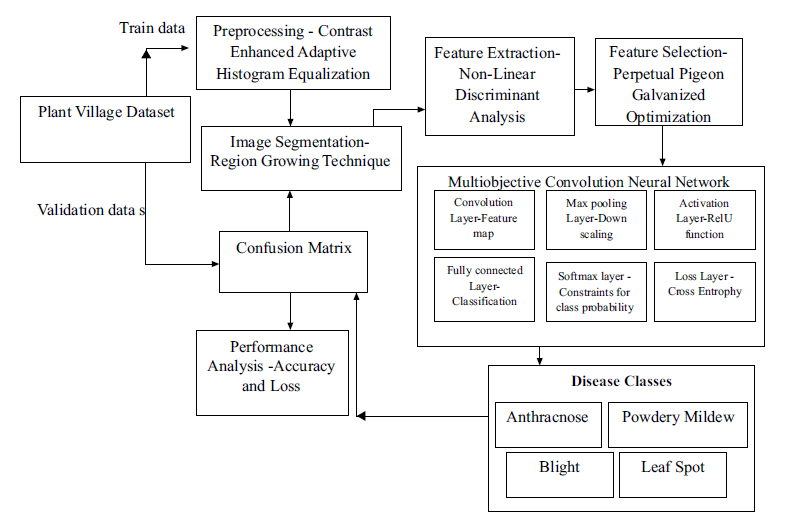
Architecture diagram of model.
3.5.1. Convolution Layer
A Convolution layer is used to generate the feature map that represents the activation of different learned features across the input image. The convolution layer computes the feature maps using the kernel to the features of the segment in the continuous sliding convolution window. In the current architecture, the feature map is convoluted by several optimal feature graphs. For the input of the optimal seed to the convolutional layer, the Feature Map is computed as follows (Eq 16):
 |
(16) |
3.5.2. Activation Layer
ReLu is used by the activation layer as an activation function. This non-linear function computes the active class for fungal, viral, and bacterial disease types using the sigmoid and tanh functions.
3.5.3. Pooling Layer
As the number of convolutional layers in the feature processing increases, the network parameters will improve the classification model. Furthermore, by computing the statistical features of a region, the pooling layer can minimize the number of network parameters for the categorization of the entire region, taking into account the characteristics of the entire region.
3.5.4. Softmax Function
The fully connected layer uses the Softmax layer in conjunction with the Naive Bayes classifier to identify the kind of disease. In addition, to reduce the feature variance across feature classes, an additional loss layer is added to the fully connected layer. The Softmax function is shown below (Eq 17):
 |
(17) |
Where ex is the feature map with a long dependency vector
The feature vector is projected using the Bayes theorem for the classifier. The theorem aggregates the related emotion traits of autistic children based on feature values using the maximum likelihood function. The findings based on the decision rule are integrated to obtain the final categorization result. Additionally, to create classes, we use feature values connected to diseases of mango plants. Equation 23 provides the maximum likelihood between the features as (Eq 18):
 |
(18) |
3.5.5. Loss Function
The loss function among the computed results is computed using the stochastic gradient descent (SGD) algorithm (Eq 19).
 |
(19) |
Where W represents the weighting function of the convolutional layer and fully connected layers, n represents the feature maps, i is the index of mapping features, and k is the class index which is represented as (Eq 20):
 |
(20) |
Where W is the learning rate, which is considered a vital parameter
3.5.6. Hyper Parameter Tuning
In this part, the model hyperparameters are tuned to attain high recognition accuracy. It varies with the model learning rate. Model optimization is carried out using the Adam optimizer approach. Further batch training approach will partition the training set and the validation set into multiple batches. Each batch is composed of 10 training images. The Hyperparameter values are represented in Table 1.
| Parameter | Value |
|---|---|
| Tuning type | Adam Optimizer |
| Base Learning rate | 0.01 |
| Epoch | 15 |
| Loss Function | Cross Entropy |
| Batch size | 10 |
3.5.7. Algorithm 1: Multiobjective Convolution Neural Network
Input: Mango Leave Image I={I1, I2,…IN}
Output: Target Disease Label L={L1, L2..LN}
Process
Image preprocess ()
Cluster (image)= { Border, Corner, Inner}
Histogram of each Region
Clip Limit: n<1<M
 |
Segment of each Region S= {S1,S2,S3}
Feature Extraction _NLDA()
Scatter matrix Sm (Segment) = F(v1,v2,v3)
Feature Selection_PPGO()
Optimal Feature FS= Fitness (F)
For (J= Feature Vector[i], J++, j<threshold)
Convolution Layer()
Feature Map= Convolve (optimal Feature)
Compute Max pooling () for Reduced Feature Map
Max pooled feature Map = Max pooled (Feature Map)
Loss function ()
Adam Optimizer() reduces over-fitting
Softmax ()
Naive Bayes Classifier (F)
Class Labels = Disease classes of Mango Plant- Viral / Fungal/ Bacterial Type
4. RESULTS AND DISCUSSIONS
Experimental analysis was carried out using the village plant dataset [15] to classify the mango plant disease into multiple disease classes. Those classes are the disease classes of the validation images. The current model is trained and validated in Python. In this processing, the image dataset is partitioned into training and validation, which consist of 80 percent for training and 20 percent for validation. Cross-fold validation was applied using the confusion matrix [16] to evaluate the performance of the classification and detection of the disease region.
In this work, the architecture of multiobjective CNN is employed in this article to achieve increased recognition accuracy for the detection of mango plant disease in the segmented regions of plants into viral, bacterial, and fungal categories etc. The present method delivers improved outcomes by determining the diseased region of pigeon distribution of pigeons of various sizes and their characteristics using Perpetual Pigeon Galvanized Optimization.
The results obtained using the Perceptual Pigeon Galvanized Optimization (PPGO) with a Multi-objective Convolution Neural Network (CNN) reflect the algorithm's strength in balancing multiple performance criteria. PPGO's unique perceptual and adaptive strategies enabled more precise feature extraction and enhanced model accuracy by dynamically adjusting to varying disease characteristics in mango leaves. The optimization effectively addressed both classification and identification challenges, demonstrating improved robustness and efficiency compared to traditional single-objective methods. The integration of PPGO allowed the model to achieve better generalization across diverse disease classes and varying leaf conditions.
4.1. Performance Evaluation Metrics
The model performance has been evaluated with training accuracy and validation accuracy, and training loss and validation loss using the values of precision and recall were computed using the confusion matrix for mango plant leaf detection and classification on various growth stages of the mango plant.
In Fig. (3), Confusion Matrix expresses the validation data in the matrix form to compute the feature and feature classes. Further matrix computations can help to generate the class results on the basis of true positive, true negative, false positive, and false negative.
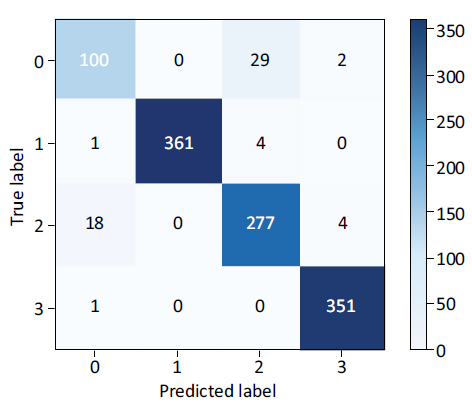
Confusion matrix.
4.1.1. Precision
It is calculated by measuring the variation among the classified results of the segment features. In other words, it can be calculated on the basis of the value of true positive (TP), false positive (FP), and false negative (FN) values of classification outcomes. It is represented as (Eq 21):
 |
(21) |
4.1.2. Recall
It is calculated as the percentage of True Positive, which calculates the disease features correctly among multiple values. It is given as (Eq 22):
 |
(22) |
4.1.3. Accuracy
It is a measure of the percentage of True Negative, which computes the disease features correctly in terms of the data's features. It is given as (Eq 23):
 |
(23) |
4.1.4. F1 Score
The F1 score, which goes from 0 to 1, strikes a compromise between recall and precision; higher values denote superior model performance. When there is an unequal distribution of classes, or when both false positives and false negatives are significant factors, it is especially helpful. The formula for the F1 score is (Eq 24):
 |
(24) |
The analysis of different mango disease samples of plant village dataset on detection and classification disease type through the current technique has been evaluated on training and validation accuracy is represented in Table 2. Training loss and validation loss have been represented as various mango leaf diseases on processing with the proposed model and various related models. It demonstrates how well the present model categorizes plant diseases. The perpetual pigeon galvanized optimization combined with a multiobjective convolution neural network performs well when compared to the state-of-the-art convolution neural network. Furthermore, by hyper-tuning its parameters, the present model offers improved performance [17].
Fig. (4) represents the performance of the model on training and validation accuracy in evaluating disease detection and classification through the proposed deep learning architecture is described. The training loss and validation loss of the model are represented in Fig. (5) for disease type detection and classification.
The suggested model's study shows that as the number of photos increases, the training and validation losses would steadily decline. Other horticultural plant diseases can be effectively treated by the trained network's performance capability. Additionally, optimal feature extractions are achieved during training by employing perpetual pigeon galvanized optimization to extract acceptable features for the given plant kinds.
4.2. Advantages of the Proposed Model
• The model has a faster propagation rate and higher recognition capability with an accuracy of 99.48%
• It processes with fewer parameters and reasonable computing time.
4.3. Limitations of the Proposed Model
• Parameter adjustment is typically necessary for minimizing robustness to diverse image configurations.
• To distinguish the overlapping feature, it has to be processed effectively.
Table 3 represents various mango leaf diseases with performance comparisons of recall, precisions, and F1scores of healthy leaves, anthracnose, bacterial black spot, and sooty mold.
| Disease | Technique | Training Accuracy | Validation Accuracy | Training Loss | Validation Loss |
|---|---|---|---|---|---|
| Leaf Spot | Perceptual Pigeon Galvanized Optimized Multiobjective Convolution Neural Network- Proposed model | 0.9998 | 0.9885 | 0.746 | 0.647 |
| Convolution Neural Network– Existing model | 0.9488 | 0.9382 | 0.714 | 0.619 | |
| Anthracnose | Perceptual Pigeon Galvanized Optimized Multiobjective Convolution Neural Network - Proposed model | 0.9997 | 0.9894 | 0.759 | 0.632 |
| Convolution Neural Network – Existing model | 0.9477 | 0.9394 | 0.689 | 0.687 | |
| Powdery Mildew | Perceptual Pigeon Galvanized Optimized Multiobjective Convolution Neural Network - Proposed model | 0.9999 | 0.9815 | 0.758 | 0.678 |
| Convolution Neural Network – Existing model | 0.9971 | 0.9715 | 0.728 | 0.787 | |
| Blight | Perceptual Pigeon Galvanized Optimized Multiobjective Convolution Neural Network | 0.9989 | 0.9846 | 0.784 | 0.714 |
| Convolution Neural Network – Existing model | 0.9458 | 0.9341 | 0.714 | 0.698 |
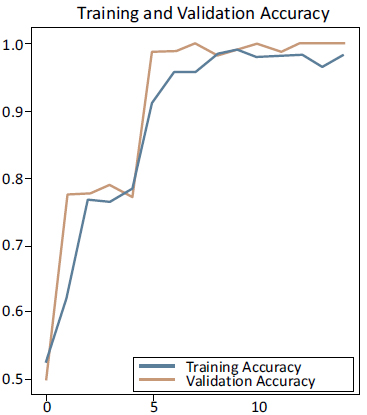
Performance evaluation of the proposed model in terms of accuracy.
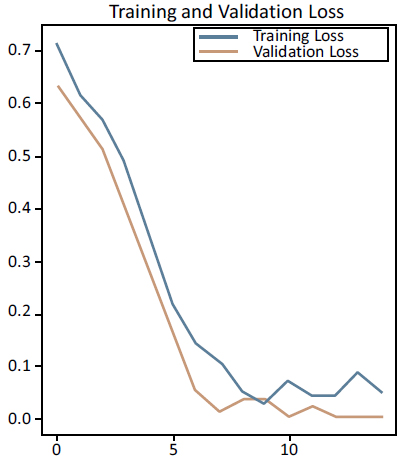
Performance evaluation of the proposed model in terms of loss.
| - | Recall | Precision | F1 Score |
|---|---|---|---|
| Healthy leaf | 97 | 99 | 97.6 |
| Anthracnose | 99.5 | 99.2 | 99.3 |
| Bacterial black spot | 96 | 98 | 94 |
| Sooty mold | 96 | 96 | 97.5 |
Fig. (6) represents the performance comparisons of recall, Precision, and F1scores of healthy leaves, anthracnose, bacterial black spot, and sooty mold, which helps to assess the prevalence, severity, and economic impact of these diseases on mango orchards. Integrated disease management strategies, including cultural practices, chemical control, and the use of disease-resistant varieties, play a crucial role in mitigating the impact of mango leaf diseases.
Furthermore, by interpreting, and addressing mango leaf diseases, farmers can optimize orchard health, ensure a robust harvest, and contribute to the long-term success of mango cultivation. Recognizing and addressing these diseases contribute to maintaining high-quality mango harvests.
Table 4 represents an accuracy comparison of our proposed model with various techniques, namely Efficient Supervised Learning Deep Neural Network(ESDNN), Hierarchical Deep Learning Support Vector Machine (HDLSVM), Ordinal Regression Neural Network(ORNN), Deep Convolutional Generative Adversarial Network (DCGAN), Convolutional Neural Network(CNN), Local Contrast Normalization Convolutional Neural Network (LCNN), Visual Geometry Group Network(VGGNET 19). Our proposed model produces an accuracy of 96%.
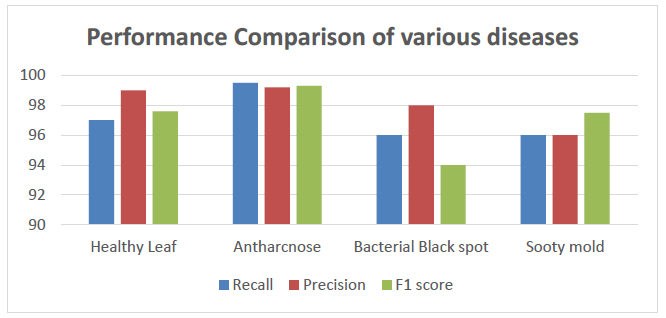
Performance evaluation of various diseases.
| Column1 | Techniques |
|---|---|
| ESDNN | 88 |
| HDLSVM | 86 |
| ORNN | 90 |
| DCGAN | 86 |
| CNN | 92 |
| LCNN | 93 |
| VGGNET 19 | 90 |
| PROPOSED | 96 |
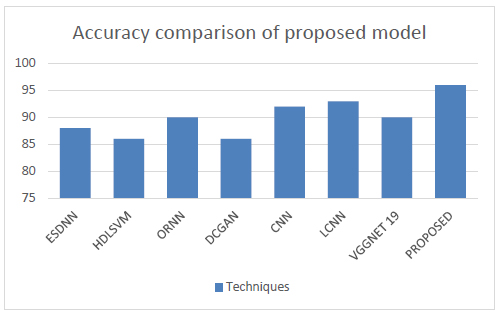
Accuracy evaluation of the proposed model.
| - | Techniques |
|---|---|
| ESDNN | 88 |
| HDLSVM | 86 |
| ORNN | 89 |
| DCGAN | 86 |
| CNN | 90 |
| LCNN | 91 |
| VGGNET 19 | 85 |
| PROPOSED | 94 |
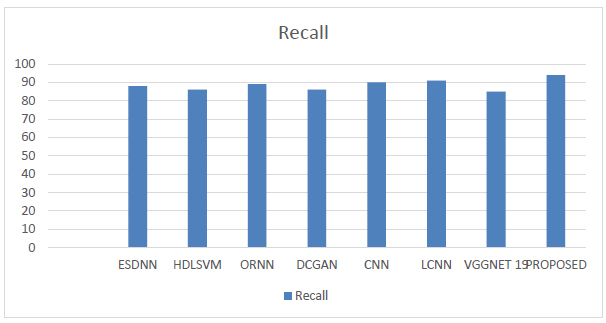
Recall comparison of the proposed model.
The accuracy comparison of our suggested model is shown in Fig. (7) above. With a 98% accuracy rate compared to alternative methods, Perpetual Pigeon Galvanized Optimization delivers a comprehensive performance evaluation based on multiple variables.
Table 5 represents the Recall comparison of our proposed model with various techniques, namely, ESDNN, HDLSVM, ORNN, DCGAN, CNN, LCNN, VGGNET 19. Our proposed model produced a recall of 94%.
Fig. (8) represents the recall comparison of the proposed mango leaf disease detection model, which receives 93% recall accuracy compared with other models.
Table 6 represents the Precision comparison of our proposed model with various techniques, namely, ESDNN, HDLSVM, ORNN, DCGAN, CNN, LCNN, VGGNET 19. Our proposed model produces a precision of 92%.
Fig. (9) shows the precision comparison of mango leaf disease with a precision accuracy of 91% compared with other models.
| - | Precision |
|---|---|
| ESDNN | 84 |
| HDLSVM | 82 |
| ORNN | 85 |
| DCGAN | 82 |
| CNN | 86 |
| LCNN | 86 |
| VGGNET 19 | 84 |
| PROPOSED | 92 |
| - | F1 Measure |
|---|---|
| ESDNN | 82 |
| HDLSVM | 83 |
| ORNN | 86 |
| DCGAN | 84 |
| CNN | 88 |
| LCNN | 88 |
| VGGNET 19 | 86 |
| PROPOSED | 92 |
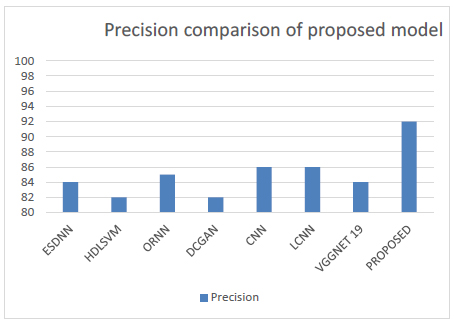
Precision comparison of the proposed model.
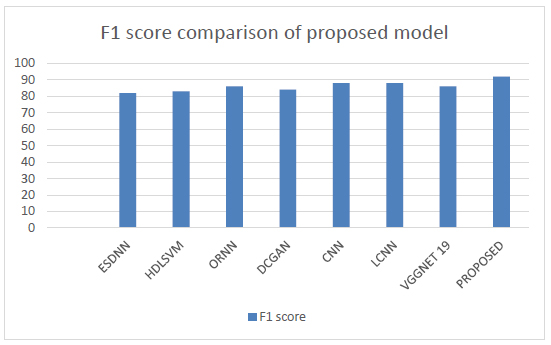
F-measure comparison of the proposed model.
Table 7 represents the F1score comparison of our proposed model with various techniques, namely, ESDNN, HDLSVM, ORNN, DCGAN, CNN, LCNN, and VGGNET 19. Our proposed model produces an F1 score of 92%.
The F1 score comparisons of the proposed model are represented in Fig. (10), with a 92% F1 score accuracy compared with other models.
CONCLUSION
In this method, the strategy and execution of a multiobjective convolution neural network with optimization using Perpetual Pigeon Galvanized Optimization is carried out to detect and classify the mango disease leaves. Initially, the pre-processing of the plant village dataset is carried out using Contrast Limited Adaptive Histogram Equalization, and the pre-processed image is segmented into several segments of the disease-infected parts of the leaf images using the region growing technique. The segmented region is employed for nonlinear discriminant analysis to extract the features of the disease region, and finally, the extracted feature is applied to Perceptual Pigeon Galvanized optimization to generate the optimal features as seed points for the classification of diseases. The further trained model produces increased computation speed and classification accuracy to identify and classify the infected region of plant leaves with small variance to represent disease types such as bacterial, fungal, and viral on familiar mango leaf diseases like algal leaf spot, anthracnose, powdery mildew, and phoma blight etc. Further validation loss can be employed using GAN architecture as a future trend to process the mango leaf disease.
AUTHORS CONTRIBUTION
It is hereby acknowledged that all authors have accepted responsibility for the manuscript's content and consented to its submission. They have meticulously reviewed all results and unanimously approved the final version of the manuscript.
LIST OF ABBREVIATIONS
| PPGO | = Perceptual Pigeon Galvanized Optimization |
| MOCNN | = Multi-objective Convolutional Neural Network |
| CNN | = Convolutional Neural Network |
| HDLSVM | = Hierarchical Deep Learning Support Vector Machine |
| ESDNN | = Efficient Supervised Learning based Deep Neural Network |
| VGGNET 19 | = Visual Geometry Group Network |
| SVM | = Support Vector Machines |


